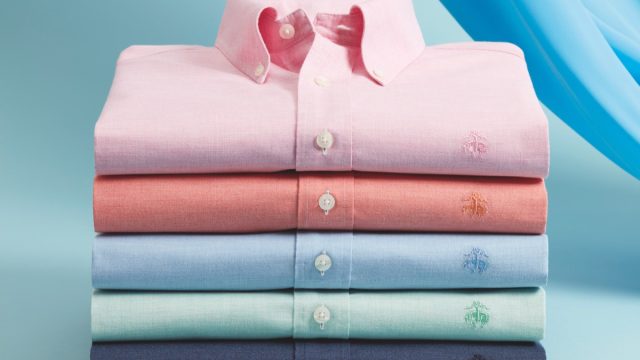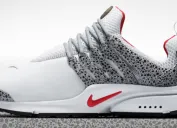How to Wear the World's Greatest Fabric: A Q&A with Buxton Midyette of Supima Cotton
"Supima cotton really is the gold standard."

For some people, cotton is just cotton. It's the stuff of crew socks and bedsheets. It's what your weekend tees are made of. It is, well, a fabric. But, in the same way that not all fabrics are created equal, not all cottons are created equal, either. There's cotton, yes—and then there's Supima cotton, an ultra-rare fiber, spun into fabric in the same aspirational class of luxury as Qiviut wool or raw Japanese denim.
In the narrowest sense, Supima cotton is pima cotton—a type of cotton with longer, stronger, finer fibers than traditional cotton—that's grown only in the Southwest United States. It's silkier to the touch than regular cotton. It's tougher than regular cotton, and can last far more wash-and-dry cycles as a result. And it's endlessly versatile, too: socks, sheets, shirts, you name it—if you can find it in regular cotton, you can find it in Supima. The sole exception? Cotton swabs. (Supima has yet to team up with Q-Tip.)
But Supima is more than just a superior fabric—it's both a movement and an organization, too. In the early part of the 20th century, cotton farmers in Arizona discovered a yield of cotton with those longer, stronger, finer fibers. So they replicated it—and consumers couldn't get enough of the stuff. By 1954, after demand for this super-powered cotton reached a fever pitch, a group of family farmers banded together to create the Supima Organization, to represent the fabric, and its producers, both domestically and abroad. Today, they're partners with many iconic fashion brands. And, according to stats compiled by the United States Department of Agriculture, Supima—or "extra-long staple cotton," in economist terms—consistently ranks among America's top cotton exporters.
To get a sense of why this sumptuous material is truly best-in-class—and why, if it's not already a staple in your closet, it should be—we sat down with Buxton Midyette, the vice president of marketing and promotions at the Supima Organization. A representative from Brooks Brothers, one of Supima's premier partners (of which there are just 10, by the way), joined the chat. Here's what they had to say.

[This interview has been condensed and edited for clarity.]
Best Life: Can you talk about the major differences between Supima and Pima cotton?
Buxton Midyette: To start off, Supima is an abbreviation for "superior Pima." And so all Supima is American-grown Pima cotton. We have five hundred family farms that grow Pima, which we then brand with the Supima trademark.
Pima, on the other hand, is used to signify the variety of cotton with what we plant. But it is not under trademark control, it's not policed, it's not reviewed in any way. So anyone can use the Pima name and apply it to any product, whereas we have very strict regulations around the licensing and use of the [Supima] trademark, and we work very hard with our partners, like Brooks Brothers, to make sure that product labeled Supima is actually made with American-grown Pima cotton.
Unfortunately, with products labeled as Pima, many times, when we test it, we find that it's not Pima at all. It's just regular cotton. So Supima really is the gold standard of Pima cotton.
Supima is the top one percent of cotton grown in the world. It's a special variety, or species, of cotton known as "extra-long staple cotton." It has a fiber length of an inch-and-a-half, compared to just one inch for regular cotton. It's also twice as strong as regular cotton, and much, much finer. You're going to get this beautiful, deep, lasting color because of the length of the fiber—and that length gives the fabric this supple, silky softness. So these fiber attributes translate into some amazing benefits, in terms of final product.
Best Life: When you said five hundred family farms, where do you find Supima grown?
Buxton: Supima is grown in the American Southwest. About 90 percent of it is grown in California, with the remaining 10 percent being grown in Arizona, New Mexico, and west Texas. We're very fortunate to have five hundred family farms that grow this cotton. These are multi-generational family farms, and it is really because of the partnership we have with Brooks Brothers to promote Supima that it allows this family tradition to continue for another generation.
Brooks Brothers: There are a few favorite stories I've learned over the nine years of partnership with Supima—about the Goodyear tire, about Charles Lindbergh…
Best Life: Let's hear some.
Buxton: A little fun fact about Supima: we have industrial heritage, which is very unique for a luxury fiber. In the early 20th century, Supima was first commercialized for the use in automobile tire industry. It's a very strong fiber and very lightweight, so the Goodyear Company bought sixteen thousand acres out in Arizona and started growing Supima, and harvested it for automobile tires, and that was the case all the way through World War II, when they developed the steel belted radio tire. So there was about six pounds of cotton in every single Model T tire, which is actually more cotton by weight than there was rubber in those tires.
Another way Supima was used, when it was first at its conception, was in aviation fabric. Actually, the first Brooks Brothers–Supima partnership was with the Spirit of St. Louis, that Charles Lindbergh historic flight across the Atlantic [in 1927]. That plane was wrapped in Supima cotton, because it is a very strong and lightweight fabric. The reason this was our first partnership is because you have Lindbergh, who flies across the Atlantic in this Supima-wrapped plane; he lands in Le Bourget, just outside of Paris, to the adulation of these crowds, and they whisk him to the center of the city, where the U.S. ambassador dresses him in a Brooks Brother suits for a grand reception. So there we were, at Brooks Brothers: you get to dress presidents, and some people we got to dress in airplanes.
Brooks Brothers: It had to be a scary flight!
Buxton: He knew how to fly in style, right? He had sartorial instincts beyond his aeronautical talents. Sadly, we are no longer in the tire business or the aviation business…but we haven't given up!

Best Life: You've said that "the core value for Supima is to support young designers, sources of creativity, and innovation." This of course includes measures like the Supima Design Competition. Can you share any other 2019 plans that further the mission?
Buxton: We've been really excited to partner with Brooks Brothers on this design competition, which is something we've done with the leading design schools in the United States for the past twelve years. And this is great: It's a tough industry. Even the most talented young designer struggles to get a foothold. So one of the things we're really shifting our attention to—now that we have developed this alumni association, so to speak, after twelve years with all these finals that have participated—is helping them find that first opportunity. So we'll be reaching out to our brands and really helping them to facilitate that process and hopefully placing these designers into jobs.
Best Life: Can you talk a little bit about what inspired the partnership between Supima and Brooks Brothers and how that came to be.
Buxton: We have a partnership that goes back decades—we have been with Brooks, who has a long use of Supima cotton for button-down oxfords. But we've been talking with Claudio Del Vecchio [the chairman and CEO of Brooks Brothers] and the leadership team of Brooks Brothers about how to work together, and that resulted in a trip to see the Supima harvest by Mr. Del Vecchio. I think, when he arrived out there—and saw the attention to detail and quality that we hold to be very dear to Supima—he really saw a perfect alignment with what Brooks Brothers does in terms of serving customers and offering the best quality goods that customers can really enjoy.
I think that was the moment the light bulb went off. So, from that moment on, I think, whenever there was an opportunity to use Supima products, that opportunity was taken. So we went from a partnership that focused initially on the classic button-down oxford, then came to include men's underwear, sweaters, and now jeans, polos, some outerwear—everything.
Brooks Brothers: We do training breakfasts with the store associates so they can really share the story and quality with the customers so that they can understand and appreciate it, too. Brooks Brothers is really known for innovation—inventing the button-down, for instance—and I think, when our CEO went to visit, he really understood the innovation that Supima farmers where bringing to the market in a way they grow their crop and harvest, and know the processes that go with it. And I think that just really aligned the two in a much more peaceful manner.
So you have innovation and you have this quality that is unsurpassed, and I think that really kind of drew us in. Then you have the connection: American-grown cotton with an American company. It all just kind of came together and made sense for us.
Buxton: Right. You have Brooks Brothers, which just celebrated it's two-hundredth anniversary–
Brooks Brothers: Two-oh-one, actually!
Buxton: Two-oh-one, and, Supima… We're on year one-hundred-and-eight of growing Supima cotton in the United States. We're a little bit junior—by a century—but it's two classic American brands working together.
Best Life: Can you talk about what Brooks Brothers is doing that sets them apart from the rest of your partners?
Buxton: With Brooks Brothers, they really know Supima well. They refer to themselves as "makers and merchants," and that really comes through and understanding all the way back to the raw material process and so they know that, to make the best, you have to start with the best. So they've really taken that appreciation for this special cotton and it's allowed them to take it into so many different product categories and roll it out seamlessly and flawlessly. Whether it's underwear or sweaters or polos or Oxford shirts, you see that two-hundred-and-one years of experience and expertise really shine through.
Brooks Brothers: I think we also have a reputation for enduring quality: there are guys that wear their dad's Brooks Brothers blazers, or still have their shirts from college or whatever. I think there is this great [desire] for quality, and that's something that Brooks Brothers has always stood for and continues to stand for: things that are timeless and enduring and really stand for something. In order to achieve that level of quality, you need a high-quality fiber.
Best Life: If a guy could only upgrade one thing in his wardrobe to Supima cotton, what should it be?
Brooks Brothers: Well, I think everything we make with Supima is just the top of the line. However, if you want to try something new, try our sweater. Because most people feel like a cotton sweater could almost be a disposable item. When we use Supima cotton, it takes the color so brilliantly, and it's going to last so long, and it's so soft and so comfortable that I think you'll see the difference between our sweater and someone else's.
We also changed our polo a couple of years ago—to introduce Supima cotton into it—and, from the moment we did that, we saw a great reaction from consumers. But, really, every item we make feels like—once you add the Supima ingredient to the recipe—it just becomes that much better. Tough choice to make!
Buxton: I would say hands down the polo. Most guys have a stack about a foot tall of polos sitting in their closet. But because of the innovations, the changes, and the re-launch, Brooks Brothers' performance polo is amazing. This is not your grandfather's polo—you're not going to have the sleeves hanging below your elbows, bellowing. It's stylish. It has a really nice cut to it. It's going to hold the color. It's going to feel great, it's going to look great, and you can add a whole new palette to your wardrobe—Brooks Brothers comes out with amazing colors every season. [Ed note: Currently, the Brooks Brothers Supima cotton performance polo is available in 23 colors.]

Best Life: Do you have any laundry tips that could help Supima cotton stay as colorful and bright for as long as possible?
Brooks Brothers: You really don't have to take any special care—just follow the washing instructions on the tag! It doesn't fade, it doesn't lose its shape. [Some] guys are still in the habit of sending their shirts out to a cleaner, which is something we have been conditioned to do. But the reality is, with, Supima non-iron shirts, you really can just wash it and dry it and its good to go.
Buxton: Save on dry cleaning!
Best Life: Is there a time of year that's best to wear Supima cotton? Do you think it preforms better in the summer or winter?
Buxton: It's certainly perfect for spring and summer, but it truly is year-round. For lot of people that are not comfortable wearing wool—that find it itchy—Supima is a perfect solution. And now that Brooks Brothers is coming out with Supima cotton sweaters in winter colors, it's truly year round in all respects.
Best Life: Do you have any style rules for wearing Supima cotton?
Buxton: You can dress it up; you can dress it down. There are some days where you really want to be bullet-proof, and that's a great day to throw on non-iron Oxford. Other days, you kind of want to take it down a few notches, and so get your traditional finished Oxford with a little wrinkle to it, a little character. I think you just pick the pieces that fit your mood and fit what you have to do for that day and go out and have at it.
Brooks Brothers: Also, we live in a time of casualization. And I think what separates someone from being dressed to being well-dressed is a certain kind of crispness, even when you're casual. So the colors aren't faded—unless intentionally. The shirt still looks crisp—even though it's cotton. There are ways that you can still have a great sense of style, but without looking messy and sloppy. And I think that, specially with the great debate over whether you still need to wear a suit to work or not, you still have to look professional and presentable. That's a place where having this level of quality makes a big difference.
Best Life: Earlier this year, Goldman Sachs relaxed their strict dress code—suits and ties are now optional. And this is just one part of a society-wide shift toward casualization, as you say. How do you see your brands playing a part in this transition?
Brooks Brothers: Especially when you're in a business environment, you still—even though the environment may be casualized—want to look your best, and I think that's the difference between Supima products and other products, They really do want to stand out, and they make you look like you are at your best. While you may not be wearing a suit everyday, or you may be wearing a suit without a tie, if you're wearing a Supima shirt, you're going to look crisp, you're going to look clean, and you're going to look professional.
And for more ways to get some Supima in your wardrobe, check out these 10 Stylish Summer Buys From Brooks Brothers!





















